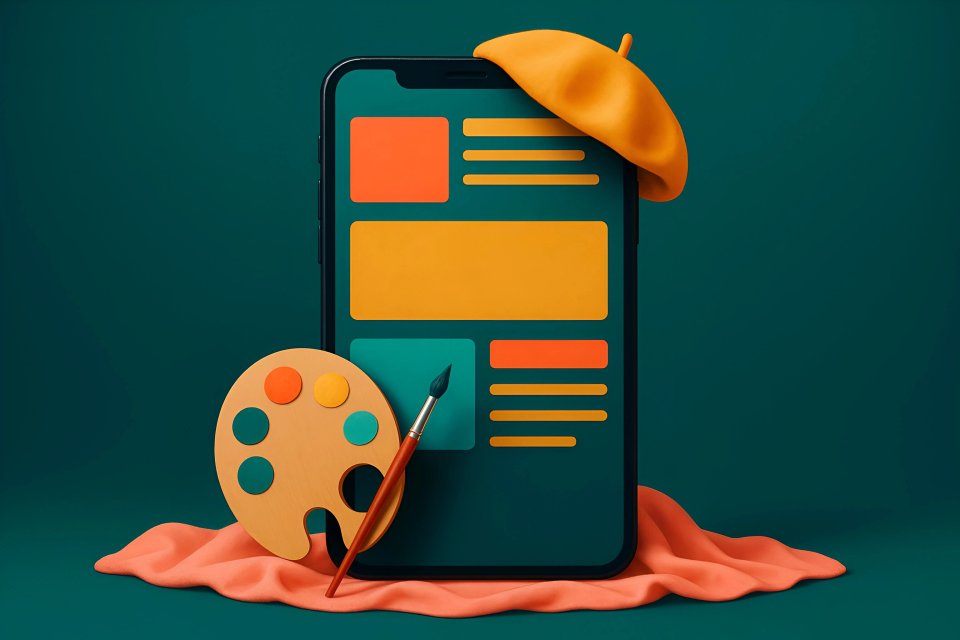Your website isn't just a digital brochure; it's the virtual front door to your brand. What story is yours telling? In a world where attention is currency, that first digital handshake can make or break you. Shockingly, it takes about 50 milliseconds (0.05 seconds) for users to form an opinion about your website that determines whether they’ll stay or leave.
Too many businesses, drowning in the day-to-day, overlook the raw power their website wields in shaping brand perception. They settle for generic templates or, worse, a digital presence that screams "amateur hour," actively repelling the very customers they crave. This isn't just a missed opportunity; it's a silent killer of growth, leading to a brand identity that's muddled, forgettable, or completely misaligned with their true value.
But what if you could change that? What if your website became your most powerful salesperson, working 24/7 to build desire, trust, and an unshakeable brand identity? This post isn't just about pretty pictures; it's your roadmap to foundational website design principles that directly forge a strong, memorable brand. At CaptivateClick, with over 15 years of crafting captivating digital experiences, we know that strategic design is the bedrock of brand identity, turning casual browsers into loyal fans.
Your Website: The Digital Embodiment of Your Brand
Listen up: your website is more than code and pixels. It's the living, breathing embodiment of your brand in the digital realm. For many, it's the very first taste they'll get of who you are and what you stand for. And as the saying goes, you never get a second chance to make a first impression – a staggering 75% of consumers admit to making judgments on a company's credibility based on the company's website design.
Think about it. The colors you choose, the images you display, the very words you use – they all whisper (or shout) volumes about your brand's personality and values. Are you bold and innovative, or traditional and trustworthy? Your design choices are the clues. A clunky, outdated site screams "we don't care," while a sleek, intuitive experience builds instant rapport and signals you're a serious player.
This isn't just about looking good; it's about building rock-solid trust and credibility. A professional, thoughtfully designed website acts as a powerful validator. Stanford research found that 46.1% of people say a website's design is the number one criterion for discerning the credibility of a company. When your digital storefront reflects the quality and care you put into your products or services, people notice. It tells them you're legitimate, you're an expert, and you're worthy of their business. CaptivateClick's approach to Branding ensures this vital alignment.
Foundational Design Principles to Magnify Your Brand
Ready to transform your website from a digital wallflower into a brand powerhouse? These aren't just "nice-to-haves"; these are the core design fundamentals that will amplify your message, captivate your audience, and etch your brand into their minds. Let's dive in.
1. Clarity & Simplicity (Less is More)
Ever landed on a website that felt like a chaotic garage sale? Overwhelming, right? The truth is, clarity and simplicity aren't just design trends; they're signs of respect for your user's precious time and attention. Your goal should be to make navigation effortless, your messaging crystal clear, and your layouts uncluttered. As Steve Krug famously advised, "Don't make me think!" – a mantra we live by.
When your website is easy to understand and use, it instantly conveys professionalism and efficiency. It tells your visitors that you value their experience and that you're confident enough in your core offerings not to hide them behind layers of digital fluff. According to Nielsen Norman Group, users appreciate predictable website structures and clear visual signposts that help them find what they need without frustration.
So, how do you achieve this coveted clarity? Prioritize your most essential information. Be ruthless in cutting out anything that doesn't serve a clear purpose. Embrace whitespace – those beautiful empty areas around your content – as it helps to reduce cognitive load and draw the eye to what truly matters. This focus on essentials is a hallmark of strong brand communication.
2. Visual Hierarchy: Guiding the Eye, Telling the Story
Imagine trying to read a newspaper where every headline, article, and advertisement was the exact same size and color. Impossible! Visual hierarchy is the art of using size, color, contrast, and placement to direct your visitor's attention to the most important elements on your page, in the right order. It's how you tell your brand's story visually, ensuring your key messages hit home.
This isn't just about aesthetics; it's about control – your control over the user's journey. A strong visual hierarchy reinforces your messaging priorities and guides the user towards the actions you want them to take, whether it's signing up for a newsletter, learning about a key service, or making a purchase. For instance, effective use of contrasting colors and a clear top-down information flow can significantly improve readability and comprehension.
Your action tip? Before you design any page, define its single most important call-to-action or message. Then, design everything else around it to support and elevate that primary goal. Make your headlines bold, your buttons pop, and your most crucial information unmissable. This strategic guidance is key to converting visitors.
3. Color Psychology & Your Brand Palette
Color is emotion. It's a primal language that speaks directly to our subconscious, influencing mood and perception long before a single word is read. Choosing colors that evoke the desired emotions and align with your brand's personality isn't just important; it's fundamental. Consistent use of these carefully selected brand colors across your website creates powerful brand recognition and forges an immediate emotional connection.
Think about iconic brands – the vibrant red of Coca-Cola, the calming blue of Facebook. These colors are instantly recognizable and deeply tied to the brand's identity. In fact, color increases brand recognition by up to 80%. Your website's color palette should be a deliberate extension of your overall brand strategy, reinforcing what you stand for.
Develop a defined brand color palette – typically a primary color, a few secondary colors, and an accent color. Use this palette consistently across every page of your site, your logo, your marketing materials, everywhere. This consistency, as highlighted in HubSpot's examples of website color schemes, is what builds that unshakeable brand recall. CaptivateClick's visual identity services focus heavily on crafting palettes that resonate.
4. Typography that Speaks Your Brand's Voice
If color is the emotion, typography is the voice of your brand. The fonts you choose can instantly convey whether your brand is modern and sleek, traditional and trustworthy, playful and fun, or sophisticated and luxurious. Beyond just looking good, your typography must ensure readability, making your content accessible and enjoyable to consume.
The right font choices add a distinct personality to your website and subtly reinforce your brand messaging. A common mistake is using too many different fonts, which can create a jarring and unprofessional experience. As a best practice, limit your website to two or three complementary fonts at most – typically one for headings and another for body text.
Ensure there's good contrast between your text color and background color for maximum legibility. Test your typography across different devices and screen sizes. Remember, your words carry your message, but your typography delivers its tone.
5. High-Quality, Authentic Imagery & Visuals
Stop using those cheesy, generic stock photos! You know the ones – the overly enthusiastic people in bland office settings. They scream "inauthentic" and do nothing to build trust or differentiate your brand. Instead, invest in high-quality, authentic imagery and visuals – original photographs, custom illustrations, or meticulously selected stock images that genuinely align with your brand's aesthetic, values, and story.
Authenticity connects. It builds an emotional bridge with your audience and makes your brand feel real and relatable. One study found that replacing stock photos with authentic imagery of team members resulted in a 35% increase in conversions. When visitors see visuals that reflect real people, real products, or unique artistic interpretations of your brand, it fosters trust and sets you apart from competitors who take the easy route.
Consider professional photography or videography that showcases your products, team, or process. If your brand leans towards the creative, custom illustrations can add a unique and memorable flair. For example, CaptivateClick's work on the Fjällbris website used stunning, unique visuals to convey the brand's deep connection to nature and tranquility, a principle also seen in Superpower.com's use of custom photography to symbolize human potential.
6. Intuitive Navigation & User Experience (UX)
Can your visitors find what they're looking for on your website quickly and easily? Or do they feel like they're trapped in a maze? Intuitive navigation and a seamless user experience (UX) are absolutely critical. If users get frustrated, they leave. It's that simple. A positive UX, on the other hand, reflects a customer-centric brand, building satisfaction, trust, and loyalty.
This means having a logical site structure, clear and concise menus, and prominent calls-to-action that guide users effortlessly through your site. Research by the Nielsen Norman Group emphasizes that users often "satisfice," meaning they choose the first reasonable option rather than searching for the optimal one. This highlights the need for clear, straightforward navigation paths.
The golden rule? Think from your user's perspective. What information are they seeking? What problems are they trying to solve? Design your navigation to answer these questions intuitively. At CaptivateClick, our UI/UX Design services are laser-focused on creating these effortless user journeys.
7. Mobile Responsiveness: Branding on Every Screen
Your customers aren't just sitting at desktops anymore. They're on smartphones, tablets, laptops – a multitude of devices with varying screen sizes. If your website doesn't look and function flawlessly on all of them, you're not just providing a bad experience; you're actively alienating a huge chunk of your potential audience. In fact, 74% of users are more likely to return to a mobile-friendly website.
Mobile responsiveness ensures your brand message is delivered consistently and effectively, no matter how it's accessed. It shows your brand is modern, accessible, and considerate of all users. This isn't a luxury; it's a baseline expectation in today's digital landscape. Using flexible grids and scalable vector graphics (SVGs) helps maintain visual integrity across all devices.
Make it a habit: regularly test your website on multiple devices and browsers. Ensure buttons are easy to tap, text is readable without zooming, and navigation is touch-friendly. A seamless mobile experience is a powerful statement about your brand's commitment to its audience.
8. Consistency is Key: Reinforcing Brand Recognition
Imagine if your favorite brand used a different logo on its website, another on its social media, and yet another on its packaging. Confusing, right? Consistency is the secret sauce for building strong brand recall and reinforcing a cohesive, trustworthy brand identity. This means maintaining unwavering consistency in the use of your logos, color schemes, typography, imagery style, and tone of voice across all your website pages and, indeed, all your brand materials.
This relentless consistency is what transforms a collection of design elements into a recognizable and memorable brand. Think of global giants like Apple or Coca-Cola; their brand elements are instantly identifiable due to decades of consistent application. Every design decision, from the color of a button to the style of an icon, should reinforce your established brand identity.
Your brand guidelines document should be your bible here. Refer to it for every design decision to ensure every touchpoint sings from the same hymn sheet. CaptivateClick often develops comprehensive Brand Guidelines for clients to ensure this powerful consistency is maintained long-term.
9. Accessibility (A11y): An Inclusive Brand Identity
Is your website welcoming to everyone, including users with disabilities? Designing for accessibility (often abbreviated as A11y, because there are 11 letters between 'A' and 'y') means creating a web experience that can be used by people of all abilities and disabilities. This includes providing alt text for images (for screen readers), ensuring keyboard navigability, maintaining sufficient color contrast, and much more.
Embracing accessibility isn't just about compliance or ticking a box; it's a powerful statement about your brand's values. It demonstrates inclusivity, social responsibility, and a genuine care for all potential users. Beyond the ethical imperative, designing for accessibility broadens your audience and can improve overall usability for everyone.
Familiarize yourself with the Web Content Accessibility Guidelines (WCAG). Simple changes, like ensuring a text contrast ratio of at least 4.5:1 (or 7:1 for WCAG AAA), can make a world of difference. An inclusive brand is a stronger brand.
From Principles to Practice: Crafting Your Brand's Digital Home
Understanding these principles is one thing; putting them into practice to forge a powerful digital extension of your brand is another. It all starts before a single pixel is placed. You must first deeply define your brand identity: its mission, its core values, who your target audience really is, and the unique personality you want to project. Every design choice must flow directly from this foundational understanding. CaptivateClick's Brand Strategy services are designed to unearth and articulate this core identity.
Tools like mood boards and style guides are invaluable in this process. Mood boards, as Adobe suggests, help to visually explore and define the aesthetic direction, collecting inspiration for colors, textures, typography, and imagery. Style guides then codify these choices, ensuring consistency as the design takes shape and evolves. Some designers even use element collages to bridge abstract brand concepts with tangible interface components, ensuring every piece fits the larger brand puzzle.
Let's look at real-world impact. For instance, when CaptivateClick redesigned the LexEnergy website, we focused on a clear visual hierarchy and strikingly modern typography. This wasn't just for looks; it was a strategic choice to reflect their innovative, forward-thinking approach in the competitive energy sector, much like the award-winning Superpower.com redesign focused on unique visuals to convey its message. Similarly, for Fjällbris, the carefully curated natural imagery and an earthy, serene color palette were absolutely crucial in conveying the brand's profound connection to nature, tranquility, and well-being. These examples show how strategic design, rooted in brand identity, creates truly resonant experiences.
Conclusion
Let's cut to the chase: effective website design is far more than just surface-level aesthetics. It's a potent, strategic weapon in your brand-building arsenal. When your website masterfully embodies the principles of clarity, visual hierarchy, emotional color use, authentic imagery, and unwavering consistency, it transforms from a passive online placeholder into an active, compelling force. It becomes a magnet, drawing visitors in, communicating your unique brand identity with power and precision, and fostering the kind of deep trust that turns prospects into lifelong advocates.
Imagine a website that doesn't just inform, but captivates. A digital experience that doesn't just function, but connects. This is the power of strategic design. It’s the difference between being just another face in the crowd and becoming an unforgettable brand that commands attention and loyalty. These design fundamentals are your keys to unlocking that potential, ensuring your brand not only survives but thrives in the bustling digital marketplace.













